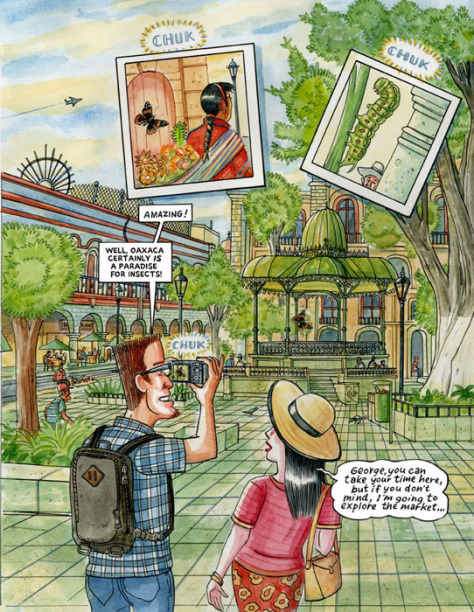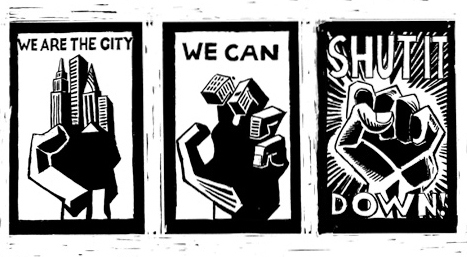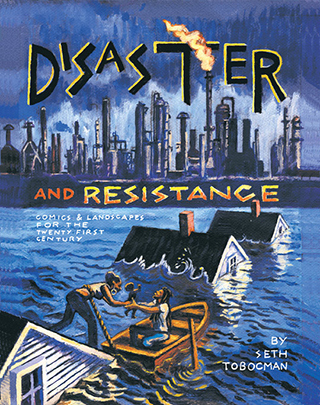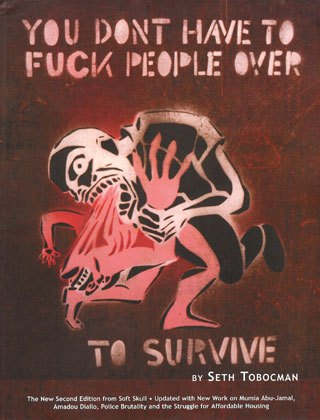 Peter Kuper’s new graphic novel, ‘Ruins’, is a breakthrough, even though this veteran cartoonist has been publishing books since 1980, producing more titles than I can count.
Peter Kuper’s new graphic novel, ‘Ruins’, is a breakthrough, even though this veteran cartoonist has been publishing books since 1980, producing more titles than I can count.Having known Peter since first grade, it could be argued that I am not objective enough to write a review of anything he produces. But I have never believed that art has much to do with objectivity. Rather, art is about the insights we gain through subjective experience. So here is what I have learned through knowing Peter Kuper that I think is relevant to a discussion of this book.
Peter Kuper grew up in a very unusual 1970’s suburban household. His mom, Ginger Kuper, was a very artsy lady. She had a desk job at the Cleveland Orchestra and was an amateur potter. The house was full of clay sculpture along with Native American textiles, block prints, plants and nature photographs. One of Peter’s uncles was an illustrator and his work decorated the walls. Another uncle was a Broadway actor. His older sisters were a dancer and a photographer. The family had a subscription to the New Yorker.
Peter’s father was a scientist, but not the kind who is lost in abstract thought. Alan Kuper (known as ‘Buzz’) liked to take walks in the woods. The family went on regular camping trips. Buzz had a subscription to National Geographic and would eventually become president of the local Sierra club. Alan Kuper was also outspoken in opposition to the Vietnam War, took his kids to peace demonstrations, allowed his son to become the first boy I knew to grow his hair long. My sister and I, along with most of our schoolmates, envied the Kuper kids for having “such nice parents”.
Peter picked up his mother’s love of art, but also his father’s love of nature. He had a butterfly collection long before he had a comic book collection and dreamed of being an entomologist before he decided to become an illustrator. From his family he gained a passion for traveling to exotic places that would continue for the rest of his life.

This background is evident in spades in Peter’s new book RUINS. The inside cover is decorated with a pattern of insects, delicately rendered. The main character is an entomologist. Most of the action takes place in the scenic landscape of Oaxaca Mexico. Many pages are dedicated to the migration and life cycle of the monarch butterfly.
It is the story of two Americans searching for their creativity in Oaxaca who run smack into the historic teachers strike of 2007 and the bloody repression that followed. The lead character is an out-of-work entomological illustrator who travels to Mexico in hope that he will start painting again. His wife wants to finish her novel and conceive a child. They meet a disillusioned photojournalist who is drinking himself to death because of things he saw in El Salvador. I won’t spoil the ending, but those who have followed events in Oaxaca can guess what happens.

But what really makes this book stand out is not what it shows but HOW it shows it. The full color drawings are lush and complex, with a lot of deep space. Both the natural beauty and the local culture are lovingly detailed. Peter knows just what the eye wants to see and he delivers, page after page.
Some will find fault that the book does not go into the political situation in Mexico that deeply. They might even accuse Kuper of exoticizing indigenous Mexicans. But Peter never pretends to speak for the locals or to be an expert on their issues. Kuper does not try to go beyond the subjective point of view of his tourist protagonists. I think this is a good and honest decision.
The mission of our generation of cartoonists has been to elevate the comic book medium; to take this “children’s toy” and make art with it. That’s a complicated project because art is a little word that covers a vast territory. It is not only Edvard Munch and Diamanda Galas, but Norman Rockwell, Paul Gaugin, Peter Max and the Beatles. There is more than one type of art. ‘Ruins’ is not an austere modernist exploration of the medium tied to important historic events like Art Spiegelman’s ‘Maus’. It is not an introspective examination of the drudgery of everyday life, like the work of Harvey Pekar, nor is it hard-hitting on-the-ground comics journalism like Joe Sacco’s.
Peter has tried on all of those hats but in ‘Ruins’, he speaks with a voice that is uniquely his own. ‘Ruins’ tells us that nature is endangered but it is also beautiful, that indigenous people are oppressed but their culture is beautiful, that creativity is hard to achieve but its results are beautiful: that life itself is short but also beautiful. Have I said the word beautiful enough times? THIS BOOK IS FUCKING BEAUTIFUL!




 Seth Tobocman is a radical comic book artist who has been living in Manhattan’s Lower East Side since 1978. Tobocman is best known for his creation of the political comic book anthology World War 3 Illustrated, which he started in 1979 with fellow artist Peter Kuper. He has also been an influential propagandist for the squatting, anti-globalization, and anti-war movements in the United States. We’re very pleased to be working with Seth, and to share his experience and knowledge with Ad Astra readers. -NMB
Seth Tobocman is a radical comic book artist who has been living in Manhattan’s Lower East Side since 1978. Tobocman is best known for his creation of the political comic book anthology World War 3 Illustrated, which he started in 1979 with fellow artist Peter Kuper. He has also been an influential propagandist for the squatting, anti-globalization, and anti-war movements in the United States. We’re very pleased to be working with Seth, and to share his experience and knowledge with Ad Astra readers. -NMB 
 Title:
Title: 






















